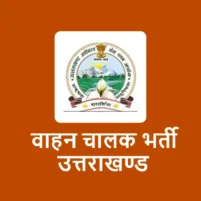UKPSC and UKSSSC invited online applications for filling up the following 388 Vacancies of Sahayak Krishi Adhikari (Grade-3 and Grade-1) in Uttarakhand Agriculture Department. All eligible candidates can apply online for the Assistant Agriculture Officer (AAO) Vacancies through the official website by 27th Oct and 05th Nov 2023. Uttarakhand Sahayak Krishi Adhikari Recruitment 2023-2024 as vacancy details, eligibility, salary, online application form, selection process, exam syllabus etc info is given below.
Sahayak Krishi Adhikari (Grade 3 and 1) Recruitment
उत्तराखंड लोक सेवा आयोग (UKPSC) द्वारा कृषि विभाग में समूह ‘ग’ के अन्तर्गत सहायक कृषि अधिकारी (वर्ग-3) के 354 रिक्त पदों पर तथा उत्तराखंड अधीनस्थ सेवा चयन आयोग (UKSSSC) द्वारा सहायक कृषि अधिकारी (वर्ग-1) के 34 रिक्त पदों पर सीधी भर्ती हेतु ऑनलाइन आवेदन पत्र आमंत्रित किए गये हैं, जिसका सम्पूर्ण विवरण इस पृष्ठ पर अपडेट किया जा रहा है।
In order to apply for direct recruitment of Group C (Samuh G) Posts, the candidate must have been registered in any employment office located in the state of Uttarakhand till the last date of receipt of application form. OR
The candidate must have domicile certificate of Uttarakhand state. OR In case the candidate does not have the domicile certificate of Uttarakhand state, then he/she must have passed his/her 10th or 12th or its equivalent level of exam from recognized institutions located in the state of Uttarakhand.
See also: Uttarakhand Samuh G Recruitment Group C Posts 2023-2024
UKPSC Sahayak Krishi Adhikari (Grade-3) Recruitment:
- Post Name and Nature: सहायक कृषि अधिकारी वर्ग-3 (स्थायी / अराजपत्रित / अंशदायी पेंशनयुक्त)।
- Department: कृषि विभाग।
- Number of Vacancies: 354 Posts (GEN-214, EWS-23, SC-75, ST-16, OBC-26).
- Pay Scale: Rs 25500-81100 (Level-04)
- Age Limit: 21 to 43 years as on 01.07.2023 (01 year relaxation in upper age limit is applicable for all candidates). Relaxation in upper age limit for SC, ST, OBC, Ex-Servicemen and other categories will be applicable as per Govt rules).
- Educational Qualification: शैक्षिक अर्हता के रूप में अभ्यर्थी के पास किसी भी मान्यता प्राप्त विश्वविद्यालय / संस्थान से कृषि में स्नातक डिग्री होनी चाहिए। अधिमानी अर्हता के रूप में, उन अभ्यर्थियों को प्राथमिकता दी जाएगी जिन्होंने प्रादेशिक सेना में न्यूनतम 02 वर्ष की अवधि तक सेवा की हो या जिन्होंने राष्ट्रीय कैडेट कोर (एनसीसी) का बी/सी प्रमाणपत्र प्राप्त किया हो।
नोट: सहायक कृषि अधिकारी (वर्ग-3) पद हेतु उत्तराखण्ड अधीनस्थ सेवा चयन आयोग द्वारा पूर्व में प्रकाशित विज्ञापन संख्या 38/UKSSSC/2021 दिनांक 01 अक्टूबर 2021 में जिन अभ्यर्थियों द्वारा आवेदन किया गया था, उन अभ्यर्थियों हेतु आयु गणना की निश्चायक तिथि 01 जुलाई 2021 है।
UKSSSC Sahayak Krishi Adhikari (Grade-1) Recruitment:
- Post Name and Nature: सहायक कृषि अधिकारी वर्ग-1, विकास शाखा (अराजपत्रित / अस्थायी / अंशदायी पेंशनयुक्त)।
- Department: कृषि विभाग (विकास शाखा)।
- Post Code: 489/434/48/2023.
- Number of Vacancies: 34 Posts (GEN-27, EWS-03, SC-04, ST-00, OBC-00).
- Pay Scale: Rs 44900-142400 (Level-07).
- Age Limit: 21 to 42 years as on 01.07.2023 (relaxation in upper age limit for SC, ST, OBC, Ex-Servicemen and other categories will be applicable as per Govt rules).
- Educational Qualification: शैक्षिक अर्हता के रूप में अभ्यर्थी के पास किसी भी मान्यता प्राप्त विश्वविद्यालय / संस्थान से कृषि में स्नातकोत्तर डिग्री होनी चाहिए। अधिमानी अर्हता के रूप में, उन अभ्यर्थियों को प्राथमिकता दी जाएगी जिन्होंने प्रादेशिक सेना में न्यूनतम 02 वर्ष की अवधि तक सेवा की हो या जिन्होंने राष्ट्रीय कैडेट कोर (एनसीसी) का बी/सी प्रमाणपत्र प्राप्त किया हो।
See also: UKPSC समीक्षा अधिकारी भर्ती | RO ARO Exam Syllabus (137 Posts)
Refer to official recruitment notification (vigyapan) for the horizontal reservation wise Sahayak Krishi Adhikari (Grade-3 and Grade-1) vacancy details.
Uttarakhand Sahayak Krishi Adhikari Selection Process
UKPSC Sahayak Krishi Adhikari (Grade-3): The recruitment process consists of Paper-1 (General Knowledge, General Studies and General Hindi) and Paper-2 (Optional Subject- Agriculture/ Biology/ Horticulture). The written exam will be of maximum 300 Marks.
Paper-1 will be of 02 Hours duration and will consist of 100 objective type questions (01 mark each). While, Paper-2 will be of 03 Hours duration and will consist of 200 objective type questions (01 mark each). Negative marking of ¼ marks will be applicable for every wrong answer given by candidates.
The written exam for the post of UKPSC Sahayak Krishi Adhikari (Grade-3) is scheduled to be held om 07th January 2024 (see exam calendar). For selection, final merit list will be prepared on the basis of marks obtained in the written examination subject to verification of documents and other details.
UKSSSC Sahayak Krishi Adhikari (Grade-1): The recruitment process consists of Objective Type written exam of 100 Marks. The Question paper will be of 02 Hours duration and will consist of 100 Objective Type Multiple Choice questions related to qualification for the post. Minimum 45 marks for GEN/ OBC and 35 marks for SC/ST are required to qualify in the written exam.
Negative marking of ¼ marks will be applicable for every wrong answer given by candidates. For selection, final merit list will be prepared on the basis of marks obtained in the written examination subject to verification of documents and other details. In the case of obtaining similar marks by two or more candidates, the merit will be determined on the basis of higher age.
The written exam for the post of UKSSSC Sahayak Krishi Adhikari (Grade-1) is scheduled to be held during the month of November 2023 (see exam calendar). Uttarakhand Subordinate Service Selection Commission is now conducting online exam along with the offline exam. Therefore, this exam may be conducted either offline or online.
You may check the Sahayak Krishi Adhikari Syllabus for UKSSSC AAO Grade-3 below. Refer to official recruitment notifications (vigyapan) for the UKPSC AAO (Grade-3) Syllabus and UKSSSC AAO (Grade-1) Syllabus.
See also: UKSSSC Syllabus Group C (Samuh G) Exam Uttarakhand
Online Application form, Important Dates and Notification
All eligible and interested candidates can apply for the UKPSC Sahayak Krishi Adhikari (Grade-3) Uttarakhand Recruitment through the website psc.uk.gov.in up to 27th Oct 2023. Before filling online application form, you will have to go through the registration process. Keep ready your mobile number, email id, educational details and scanned images of photograph (20-50kb) and signature (10-50kb) in JPG format.
To apply for UKSSSC Sahayak Krishi Adhikari (Grade-1) Recruitment, eligible and interested candidates will have to go through the UKSSSC OTR (One Time Registration) process. You will have to keep ready scanned images of recent passport size photograph, signature and left thumb impression (maximum 50 KB each) to upload online. After registration, you can submit online application form through the website sssc.uk.gov.in upto 05th November 2023.
You are advised to read the official advertisement (vigyapan) carefully and follow all the instructions given for submission of online application form. After successful submission on online application, take a printout of the system generated form for record and future correspondence.
Application fee:
UKPSC Sahayak Krishi Adhikari (Grade-3): All candidates have been given exemption in exam fee and processing fee.
UKSSSC Sahayak Krishi Adhikari (Grade-1):
GEN/ OBC Category – Rs 300/-
EWS/ SC/ ST/ DIVYANG Category – Rs 150/-
ORPHAN Category – Nil
The requisite fee can be remitted by using Net Banking/ Debit Card/ Credit Card/ UPI/ CSC Centre.
Important Dates
UKPSC Sahayak Krishi Adhikari (Grade-3):
Commencement of submission of online application – 07th October 2023
Last date for submission of online application – 27th October 2023
Correction in online application – After 05 days of closing of application
Exam date (tentative) – 07th January 2024 (Check Exam Calendar)
UKSSSC Sahayak Krishi Adhikari (Grade-1):
Commencement of submission of online application – 05th October 2023
Last date for submission of online application – 05th November 2023
Correction in online application – 09th to 16th November 2023
Exam date (tentative) – November 2023 (Check Exam Calendar)
Register and submit online application form by visiting at the direct links provided below (available from 05.10.2023). For more details about the Uttarakhand Sahayak Krishi Adhikari Recruitment 2023-2024, download the official UKPSC AAO Grade-3 Notification (A-2/ DR(AHA)/ S-1/ 2023-24) and UKSSSC AAO Grade-1 Notification (48/UKSSSC/2023) in pdf formats.
- UKPSC AAO Grade-3 Notification
- UKPSC AAO Application Portal
- UKSSSC AAO Grade-1 Notification
- UKSSSC AAO Application Portal
- Krishi Vibhag Official Website
Sahayak Krishi Adhikari Syllabus (Grade-3)
Syllabus provided by the Uttarakhand Subordinate Service Selection Commission (UKSSSC) for the Assistant Agriculture Officer (Sahayak Krishi Adhikari) Grade-3 exam is as follows (refer to official notifications for the Syllabus of UKPSC AAO Grade-3 and UKSSSC AAO Grade-1 exam):
UNIT-1 Syllabus
Definition and scope of Agronomy, Classification of field Crops, general principles of Crop production: Climate, soil, soil preparation, seed and sowing, tillage, water management, nutrient management, plant protection management, harvesting, threshing and storage, mixed and inter-cropping, manure and fertilizers.
cultivation of common crops- Cereal Crops: Wheat, Barley, Oat: oilseed Crops: Rapeseed and mustard Linseed, Sunflower; Pulse crops: Chick pea, field pea, Lentil, Rajmah, Fodder Crops : Oat, Berseem, Lucerne; Cash Crops; Potato, sugarcane, recommended varieties, seed rate, time and method of sowing, irrigation, manure and fertilizer, weed controls, insect-pests and diseases, harvesting, processing and yield.
Soils- origin and classification loam, silt, clay, sandy loam, physical and chemical properties of soil. Use of fertilizers, essential nutrients- nitrogen, phosphorus and potassium, organic and inorganic fertilizers and their effects on crops and soil, FYM and green manauring, water requirement of crops, measurement of water discharge, prevention of loss of water.
different methods of irrigation – flooding, basin method, border /strip method, sprinkler and drip irrigation. Disadvantage of excess moisture, prevention of formation of acidic and alkaline soils and their management.
UNIT-2 Syllabus:
Study of horticultural crops including recommended varieties and their main features, suitability for different regions, time and method of sowing, manure and fertilizer, irrigation, diseases and pests and their control. Major vegetables like Potato, Brinjal, chillies, tomato, Cauliflower, Cabbage, knol khol, Onion, Watermelon, Okra, Radish, Carrot and Pea.
Cucurbits, bittergourd, bottlegourd, muskmelon, ridge gourd, root crops-carrot, radish sweet potato, turnip, fruits vegetables-tomato, bringal, botanical Classification of vegetables and fruits, pruning and training of fruit plants, Unfruitfulness, Fruit drop, Polyembryony, Parthenocarpy and incompatibility.
Practices involved in the production of fruits: Mango, Guava, Kagzi lime, Banana, Grape, Litchi, Papaya, Loquat, Aonla, Ber, Jack Fruit, Apple, Pear and Peach, Production techniques of plantation crops: Coconut, Cashew nut, Tea Coffee and coca.
UNIT-3 Syllabus:
Type of iron and steel, wood, plastic and tin used in agricultural implements and their forms &, properties. Study of different types of ploughs- indigenous, chisel, rotary and disc plough, their management & cost, selection of prime movers, water lifting devices; discharge, command area, cost of different system; soil preparation, methods of ploughing, need for tillage, kinds of tillage, mechanical Power transmission through belts, pullies and gears, EC engine and its components.
Classification of tractors, Elementary knowledge about main components of tractor and their functions such as steering, clutches, transmission gears, differential and final drive, Introductory agricultural economics-meaning and scope.
Production- meaning, factors of production such as land, labour, capital and management, properties of factor of production; law of returns; intensive and extensive agriculture, law of demand, relative prices and standard of living; Cooperation – meaning, principles of cooperation, land development banks: Agriculture-place in Five Year Plans; Extension Education, Extension Teaching and Learning. Extension and Rural Development Programmes: Including T and V system, National Demonstration, IRDP, Jawahar Rojgar Yozana.
UNIT-4 Syllabus:
Study of major breeds of cow, buffalo, goat, sheep, poultry and Pig; Physiology and anatomy of cow and buffalo; characteristics of good milch cow and buffalo, bulls and bullocks. Care and management of pregnant cow, poultry management. Principles of feeding of various classes of livestock and poultry. Clean milk production and maintenance of hygiene. Common medicines and vaccines used in treatment/prevention and control of animal diseases; handling of animals for treatment; castration.
Operation flood, Milk and Milk products, Identification of Adult rated milk, Importance of farm’s livestock and poultry in agriculture and Indian economy, Pathogenesis disease and vaccination. The antigens, antibiotics, antiseptics, disinfectants, The milk and its synthesis in mammary glands. Composition of milk of different species and colostrum.
Details composition and physio-chemical properties of cow and buffalo’s milk. Factors affecting quantity and chemical composition of milk. Chemistry of milk constituents viz. lactose, fat, protein, enzymes and vitamins. Preservatives and adulterants of milk. Chemical changes occurring during storage of milk. Classification of common feeds and fodders, low-cost balanced feeds, Evaluation of energy and protein value of feed.
Processing methods of animal feed stuffs. Processing of milk for filtration, clarification, bactofugation, standardization, homogenization, cream separation-centrifugation. Indigenous milk products- paneer, chhana, ghee, khoa, dahi. Other milk products- cream, butter, ice-cream, condensed milk, milk powder, cheese, dairy by products.
UNIT-5 Syllabus:
Mendel’s Law’s of heredity, Chromosomal theory of inheritance, meiosis and mitosis, Linkage and crossing over- types, mechanism and significance, Nucleic acid as genetic material- structure, replication, genetic code and translation, Mutation- spontaneous and induced, Sex chromosomes and its determination in man and droisophila, sex linked characters. Mean as measures of central tendency-Mean, Median, Mode, Geometric Mean, Harmonic Mean, Weighted Range, Quartile Deviation, Variance, Standard Deviation and Coefficient of variation.
Chemistry of Carbohydrates- Glucose, fructose, Galactose, Sucrose, Lactose, Maltose, Starch, Cellulose. Ammo acids, Lipids and fatty acids. Vitamin A, D, E, K, Thiamine, Riboflavin and Nicotinic acid, Plant growth substances, photoperiodism and verbalization, Insect Anatomy: Digestive, Exeretory, Reproductive, Circulatory, Respiratory and Nervous systems of grasshopper, General introduction to Phylum Arthropoda, class Insecta, Mode of reproduction in crop plants in relation to breeding techniques.
Genetic consequences of self and cross pollinated crops, Plant Introduction and exploration, Breeding self pollinated crops, population’s improvement, Mass selection, recurrent selection. Breeding cross pollinated crops mass selection, pedigree, bulk and back cross methods. Classification of plant diseases according to cause and occurrence. Plant Pathogens: Fungi (Albugo, Erysiphe, Ustilago, Claviceps and Puccinia).
Diagnositic characters of the following genera: Phytophthora, Peronospora, Sclerospora, Ustilago, Sphacelotheca, Tolyposporium, Melampsora, Alternaria, Cercospora, Fusarium, Helminthosporium, pyricularia, Rhizoctonia and Colletotrichum. Preliminary knowledge of hazards related to pesticide use, MRL, ADI, Mammalian Safety Ratio. Basic concept of Integrated Pest Management.
Check the given link for the Written Exam Syllabus and Pattern of all other Group C posts.
See also: UKPSC Syllabus Group C (Samuh G) Exam Uttarakhand
Search any information available on this site by the help of the search box above. You may visit later on this page for more updates related to Uttarakhand Sahayak Krishi Adhikari Recruitment, Krishi Vibhag Vacancy, UKSSSC Assistant Agriculture Officer Exam etc.




How can apply uksssc group c Pasudhan prasar adikari
See the related information on this page.